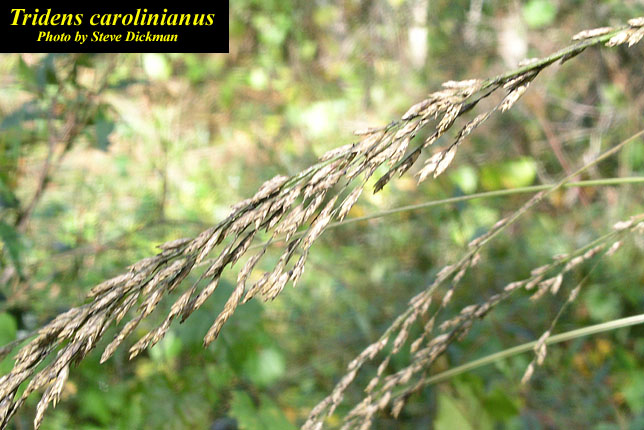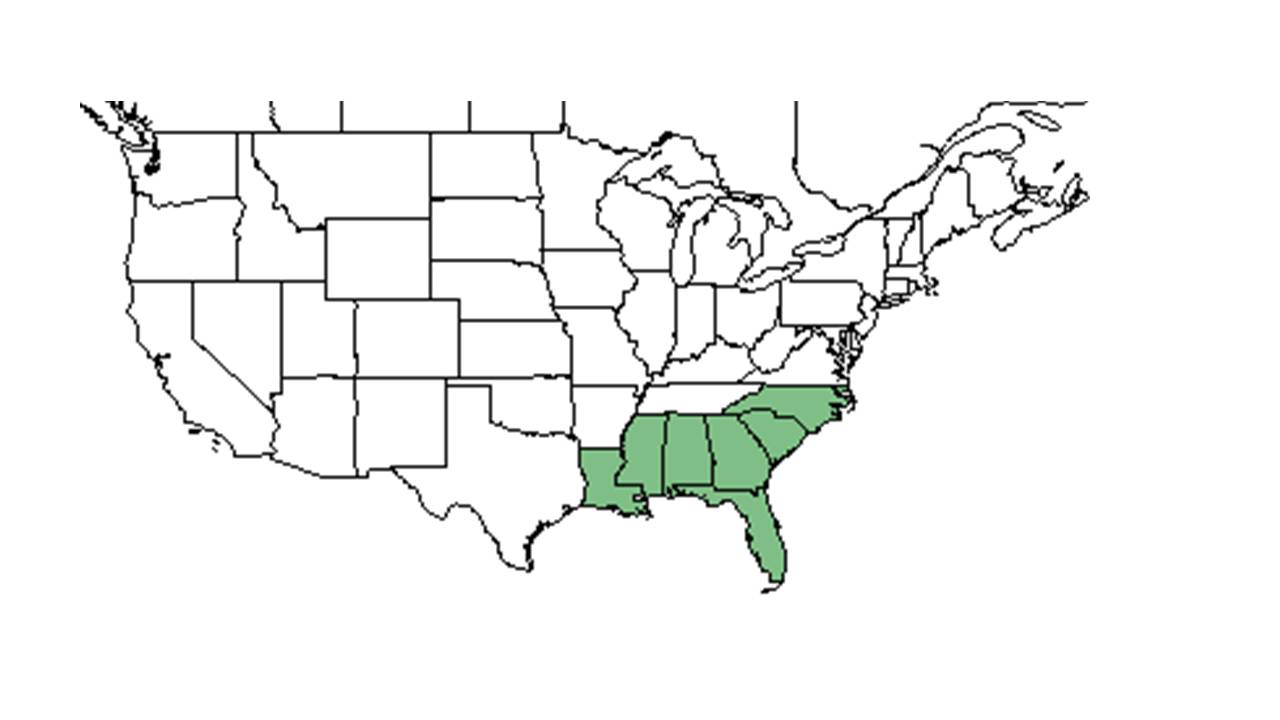Difference between revisions of "Tridens carolinianus"
(Created page with "{{italic title}} <!-- Get the taxonomy information from the NRCS Plants database --> {{taxobox | name = Tridens carolinianus | image = Insert.jpg | image_caption = | regnum =...") |
HaleighJoM (talk | contribs) (→Ecology) |
||
| (32 intermediate revisions by 9 users not shown) | |||
| Line 3: | Line 3: | ||
{{taxobox | {{taxobox | ||
| name = Tridens carolinianus | | name = Tridens carolinianus | ||
| − | | image = | + | | image = Trid_caro.jpg |
| − | | image_caption = | + | | image_caption = Photo by Steve Dickman, [http://www.florida.plantatlas.usf.edu/Default.aspx Atlas of Florida Vascular Plants] |
| regnum = Plantae | | regnum = Plantae | ||
| divisio = Magnoliophyta – Flowering plants | | divisio = Magnoliophyta – Flowering plants | ||
| Line 15: | Line 15: | ||
| binomial_authority = (Steud.) Henr. | | binomial_authority = (Steud.) Henr. | ||
| range_map = TRID_CARO_dist.jpg | | range_map = TRID_CARO_dist.jpg | ||
| − | | range_map_caption = Natural range of ''Tridens carolinianus'' from USDA NRCS [http:// | + | | range_map_caption = Natural range of ''Tridens carolinianus'' from USDA NRCS [http://plants.usda.gov/core/profile?symbol=TRCA4 Plants Database]. |
}} | }} | ||
| + | |||
| + | Common names: Carolina fluffgrass, Carolina triodia | ||
| + | ==Taxonomic notes== | ||
| + | Synonym: ''Triodia drummondii'' Scribner & Kearney.<ref>Weakley, A.S. 2015. Flora of the southern and mid-atlantic states. Working Draf of 21 May 2015. University of North Carolina at Chapel Hill, Chapel Hill, North Carolina.</ref> | ||
| + | |||
==Description== | ==Description== | ||
<!-- Basic life history facts such as annual/perrenial, monoecious/dioecious, root morphology, seed type, etc. --> | <!-- Basic life history facts such as annual/perrenial, monoecious/dioecious, root morphology, seed type, etc. --> | ||
| + | "Erect rhizomatous perennials. Spikelets compressed, glumes similar, shorter than lowest lemma. Lemmas 3-nerved, nerves ciliate, reduced upward, chartaceous; paleas equaling lemmas. Articulation below florets."<ref name="Radford et al 1964">Radford, Albert E., Harry E. Ahles, and C. Ritchie Bell. Manual of the Vascular Flora of the Carolinas. 1964, 1968. The University of North Carolina Press. 63. Print.</ref> | ||
| + | |||
| + | "Perennial from elongate, scaly rhizomes, 2.5-5 mm thick; culms 8-12 dm tall, nodes and internodes glabrous. Leaves cauline, to 3.5 dm log, 2-7 mm wide; upper blades glabrous on both surfaces, lower blades sparsely pilose on both surfaces basally, margins smooth scaberulous; upper sheaths glabrous, lower, pilose; ligules ciliolate, 0.5 mm long. Panicle 9-15 cm long, 1-4 cm broad; branches ascending, glabrous. Spikelets 4-5 flowered, 7-9 mm long, 2-3 mm broad. Glumes 1-nerved, chartaceous, glabrous, retuse, cuspidate; 1st glume 3.5-4.5 mm long, 2nd glume 4-5 mm long; lemmas retuse, cuspidate, longest 4-5 mm long. Grain yellowish, ellipsoid, 2-2.5 mm long."<ref name="Radford et al 1964"/> | ||
| + | |||
==Distribution== | ==Distribution== | ||
| + | ''Tridens carolinianus'' is endemic to the east Gulf Coastal Plain, disjunct to North and South Carolina.<ref>Sorrie, B. A. and A. S. Weakley 2001. Coastal Plain valcular plant endemics: Phytogeographic patterns. Castanea 66: 50-82.</ref> | ||
| + | |||
==Ecology== | ==Ecology== | ||
===Habitat=== <!--Natural communities, human disturbed habitats, topography, hydrology, soils, light, fire regime requirements for removal of competition, etc.--> | ===Habitat=== <!--Natural communities, human disturbed habitats, topography, hydrology, soils, light, fire regime requirements for removal of competition, etc.--> | ||
| + | In the Coastal Plain in Florida and Georgia, ''T. carolinianus'' has been found in open longleaf pine forests; loamy sand of open pinewoods sandhill; annually burned pinelands; longleaf pine-live oak forests; sandy loam of longleaf pine-deciduous scrub oak forests; mesic longleaf pine-oak-persimmon community; and open, mesic pine flatwoods.<ref name="FSU Herbarium">Florida State University Robert K. Godfrey Herbarium database. URL: [http://herbarium.bio.fsu.edu http://herbarium.bio.fsu.edu]. Last accessed: July 2015. Collectors: Loran C. Anderson, Wilson Baker, Robert K. Godfrey, Roy Komarek, Angus Gholson, J. M. Kane, R. Kral, John B. Nelson, B. A. Sorrie. States and Counties: Florida: Gulf, Jackson, Santa Rosa, Wakulla, Walton, Washington. Georgia: Baker, Grady, Thomas. Compiled by Tall Timbers Research Station and Land Conservancy.</ref> It has also been found in disturbed habitats such as pastures and old fields. Associated species include ''[[Quercus margarettae]], [[Quercus incana]], [[Quercus falcata]], [[Liatris gracilis]], Liatris tenuifolius, [[Ceanothus americanus]], Aristida beyrichiana, [[Pityopsis graminifolia]] var. tenuifolia, Schizachyrium tenerum, Eriogonum tomentosum, [[Licania michauxii]]'', and ''Ctenium.''<ref name="FSU Herbarium"/> | ||
| + | |||
===Phenology=== <!--Timing off flowering, fruiting, seed dispersal, and environmental triggers. Cite PanFlora website if appropriate: http://www.gilnelson.com/PanFlora/ --> | ===Phenology=== <!--Timing off flowering, fruiting, seed dispersal, and environmental triggers. Cite PanFlora website if appropriate: http://www.gilnelson.com/PanFlora/ --> | ||
| + | This species has been observed to flower and fruit August through November.<ref name="FSU Herbarium"/><ref>Nelson, G. [http://www.gilnelson.com/ PanFlora]: Plant data for the eastern United States with emphasis on the Southeastern Coastal Plains, Florida, and the Florida Panhandle. www.gilnelson.com/PanFlora/ Accessed: 19 MAY 2021</ref> | ||
| + | |||
===Seed dispersal=== | ===Seed dispersal=== | ||
| − | ===Seed bank and germination== | + | This species is thought to be dispersed by gravity.<ref>Kirkman, L. Katherine. Unpublished database of seed dispersal mode of plants found in Coastal Plain longleaf pine-grasslands of the Jones Ecological Research Center, Georgia.</ref> |
| − | ===Fire ecology=== <!--Fire tolerance, fire dependence, adaptive fire responses--> | + | <!--===Seed bank and germination==--> |
| − | ===Pollination=== | + | |
| − | === | + | ===Fire ecology===<!--Fire tolerance, fire dependence, adaptive fire responses--> |
| − | ===Diseases and parasites=== | + | Populations of ''Tridens carolinianus'' have been known to persist through repeated annual burning.<ref>Platt, W.J., R. Carter, G. Nelson, W. Baker, S. Hermann, J. Kane, L. Anderson, M. Smith, K. Robertson. 2021. Unpublished species list of Wade Tract old-growth longleaf pine savanna, Thomasville, Georgia.</ref> |
| − | ==Conservation and | + | <!--===Pollination===--> |
| − | == | + | <!--===Herbivory and toxicology=== <!--Common herbivores, granivory, insect hosting, poisonous chemicals, allelopathy, etc.--> |
| + | <!--===Diseases and parasites===--> | ||
| + | |||
| + | ==Conservation, cultivation, and restoration== | ||
| + | |||
| + | ==Cultural use== | ||
| + | ==Photo Gallery== | ||
| + | <gallery widths=180px> | ||
| + | </gallery> | ||
| + | |||
==References and notes== | ==References and notes== | ||
| − | |||
Latest revision as of 08:29, 18 July 2022
| Tridens carolinianus | |
|---|---|

| |
| Photo by Steve Dickman, Atlas of Florida Vascular Plants | |
| Scientific classification | |
| Kingdom: | Plantae |
| Division: | Magnoliophyta – Flowering plants |
| Class: | Liliopsida – Monocotyledons |
| Order: | Cyperales |
| Family: | Poaceae ⁄ Gramineae |
| Genus: | Tridens |
| Species: | T. carolinianus |
| Binomial name | |
| Tridens carolinianus (Steud.) Henr. | |

| |
| Natural range of Tridens carolinianus from USDA NRCS Plants Database. | |
Common names: Carolina fluffgrass, Carolina triodia
Contents
Taxonomic notes
Synonym: Triodia drummondii Scribner & Kearney.[1]
Description
"Erect rhizomatous perennials. Spikelets compressed, glumes similar, shorter than lowest lemma. Lemmas 3-nerved, nerves ciliate, reduced upward, chartaceous; paleas equaling lemmas. Articulation below florets."[2]
"Perennial from elongate, scaly rhizomes, 2.5-5 mm thick; culms 8-12 dm tall, nodes and internodes glabrous. Leaves cauline, to 3.5 dm log, 2-7 mm wide; upper blades glabrous on both surfaces, lower blades sparsely pilose on both surfaces basally, margins smooth scaberulous; upper sheaths glabrous, lower, pilose; ligules ciliolate, 0.5 mm long. Panicle 9-15 cm long, 1-4 cm broad; branches ascending, glabrous. Spikelets 4-5 flowered, 7-9 mm long, 2-3 mm broad. Glumes 1-nerved, chartaceous, glabrous, retuse, cuspidate; 1st glume 3.5-4.5 mm long, 2nd glume 4-5 mm long; lemmas retuse, cuspidate, longest 4-5 mm long. Grain yellowish, ellipsoid, 2-2.5 mm long."[2]
Distribution
Tridens carolinianus is endemic to the east Gulf Coastal Plain, disjunct to North and South Carolina.[3]
Ecology
Habitat
In the Coastal Plain in Florida and Georgia, T. carolinianus has been found in open longleaf pine forests; loamy sand of open pinewoods sandhill; annually burned pinelands; longleaf pine-live oak forests; sandy loam of longleaf pine-deciduous scrub oak forests; mesic longleaf pine-oak-persimmon community; and open, mesic pine flatwoods.[4] It has also been found in disturbed habitats such as pastures and old fields. Associated species include Quercus margarettae, Quercus incana, Quercus falcata, Liatris gracilis, Liatris tenuifolius, Ceanothus americanus, Aristida beyrichiana, Pityopsis graminifolia var. tenuifolia, Schizachyrium tenerum, Eriogonum tomentosum, Licania michauxii, and Ctenium.[4]
Phenology
This species has been observed to flower and fruit August through November.[4][5]
Seed dispersal
This species is thought to be dispersed by gravity.[6]
Fire ecology
Populations of Tridens carolinianus have been known to persist through repeated annual burning.[7]
Conservation, cultivation, and restoration
Cultural use
Photo Gallery
References and notes
- ↑ Weakley, A.S. 2015. Flora of the southern and mid-atlantic states. Working Draf of 21 May 2015. University of North Carolina at Chapel Hill, Chapel Hill, North Carolina.
- ↑ 2.0 2.1 Radford, Albert E., Harry E. Ahles, and C. Ritchie Bell. Manual of the Vascular Flora of the Carolinas. 1964, 1968. The University of North Carolina Press. 63. Print.
- ↑ Sorrie, B. A. and A. S. Weakley 2001. Coastal Plain valcular plant endemics: Phytogeographic patterns. Castanea 66: 50-82.
- ↑ 4.0 4.1 4.2 Florida State University Robert K. Godfrey Herbarium database. URL: http://herbarium.bio.fsu.edu. Last accessed: July 2015. Collectors: Loran C. Anderson, Wilson Baker, Robert K. Godfrey, Roy Komarek, Angus Gholson, J. M. Kane, R. Kral, John B. Nelson, B. A. Sorrie. States and Counties: Florida: Gulf, Jackson, Santa Rosa, Wakulla, Walton, Washington. Georgia: Baker, Grady, Thomas. Compiled by Tall Timbers Research Station and Land Conservancy.
- ↑ Nelson, G. PanFlora: Plant data for the eastern United States with emphasis on the Southeastern Coastal Plains, Florida, and the Florida Panhandle. www.gilnelson.com/PanFlora/ Accessed: 19 MAY 2021
- ↑ Kirkman, L. Katherine. Unpublished database of seed dispersal mode of plants found in Coastal Plain longleaf pine-grasslands of the Jones Ecological Research Center, Georgia.
- ↑ Platt, W.J., R. Carter, G. Nelson, W. Baker, S. Hermann, J. Kane, L. Anderson, M. Smith, K. Robertson. 2021. Unpublished species list of Wade Tract old-growth longleaf pine savanna, Thomasville, Georgia.